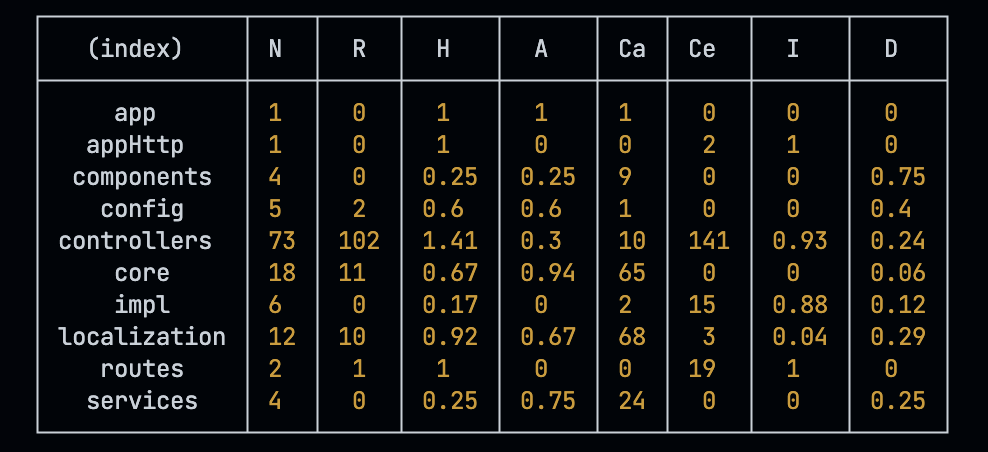ts-pkg-metrics v0.1.3
TypeScript Package Metrics
Measure the health of your app architecture

Introduction
An app's architecture is sound if the boundaries between its packages are sharp. Boundaries are sharp when packages are internally cohesive and externally loosely coupled. Such packages are also extremely easy to extract out into a microservice.
This tool helps you measure a few critical metrics of your packages that translate directly to how sound your architecture is.
Installation
Local install
You can install the tool locally into your project by running:
$ npm install ts-pkg-metricsYou can then use by either running it via npx:
$ npx ts-pkg-metrics [options]Or via npm by adding it to your package.json scripts:
{
"scripts": {
"metrics": "ts-pkg-metrics [options]"
}
}Then running it:
$ npm run metricsGlobal install
If you choose to install this tool globally, run the following (you may need sudo):
$ npm install --global ts-pkg-metricsThen run it from anywhere:
$ ts-pkg-metrics [options]How to use
The CLI accepts one optional argument and some options:
$ ts-pkg-metrics [options] [project-dir]Arguments
project-dir
The directory of the project. You may omit it if your package structure is directly at the root
level of your project. But if you have your packages inside, say, a folder named src, you will
need to specify src as the argument.
Running this command will print a table listing all the detected packages along with their metrics.
Each direct folder inside project-dir is considered a standalone package.
Options
-s, --safe <pkgs...>
Specifies a list of packages that are dependency-safe (see below).
-t, --ts-config <config-dir>
If your tsconfig.json file lives somewhere other than the root directory, you may specify it here.
-r, --reporter <type>
The type of reporter (how the results are printed). Currently, there are two reporters:
| Graph | Plain |
|---|---|
 |  |
Metrics
These metrics are described in detail in "Chapter 20: Principles of Package Design" of "Agile Software Development: Principles, Patterns, and Practices" by Robert C. Martin.
N - Number of classes
The number of classes in the package.
The implementation in this tool counts the number of exported symbols of all modules within the package. Thus, a class in this context is any exported symbol.
R - Internal relationships
The number of times a class has imported another class within the same package.
Note that if more than one class (exported symbol) exist in the same module (file) and depend on
each other, this metric won't reflect that. The tool depends on import statements to calculate
this metric. For the most accurate results, you may need to limit exported symbols per module to
one.
H - Relational cohesion
A metric that combines both N and R and is calculated as follows:
H = (R + 1) / N
The higher this metric, the better.
A - Abstractness
The number of abstract classes in the package.
Interfaces, types, and abstract classes count into this metric. Any other exported symbol is considered non-abstract.
Ca - Afferent couplings
The number of times another package has imported any symbol from within this package.
This metric represents how dependent other packages are on this package.
Ce - Efferent couplings
The number of times this package has imported any symbol from other packages.
This metric represents how dependent this package is on other packages.
The sum of all Ca values is always equal to the sum of all Ce values:
Σ Ca = Σ Ce
I - Instability
A metric that combines both Ca and Ce and is calculated as follows:
I = Ce / (Ca + Ce)
I falls within the range (0,1), where 0 means a completely stable package and 1 means a completely instable package. Here, instability isn't a bad thing: it means that this package is fully dependent on other packages while no other package is dependent on it. On the other hand, stability means the package is fully independent of other packages while other packages depend on it.
S - Dependency-safety
S is a flag set by the user that marks a package as dependency-safe. That is, it means a package is safe to be both stable and concrete. A user may decide that a package is dependency-safe in certain cases such as:
- Presentational packages: A package that has concrete implementations of UI components will probably be highly stable (many packages depend on it).
- Non-volatile packages: A package may have a concrete implementation of a utility class (e.g.,
a
StringUtilsclass) that is known for the client to be highly non-volatile (it won't change much).
The value is either 0 or 1, with 0 being the default.
D - Normal distance
This metric measures how far this package is from the "sweet spot" of instability vs. abstractness. In short, a fully abstract package should be fully stable, and a fully concrete package should be fully instable:
D = | A + I − 1 |
D falls within the range (0,1). The lower this metric, the better.
If S is set to 1, it overrides the value of I in the equation. The normal distance becomes the same as the abstractness.
If the value of D is calculated without the absolute function, then its sign is interpreted as follows:
- If negative, the package is too concrete for its stability. Dealing with such packages is generally painful.
- If positive, the package is too abstract for its instability. Such packages generally indicate a bad design as they are expected to be more stable for being abstract. They are generally considered useless.
What to aim for
As a rule of thumb, a software architect should mostly focus on getting all the H values as high as possible while getting all the D values as low as possible.